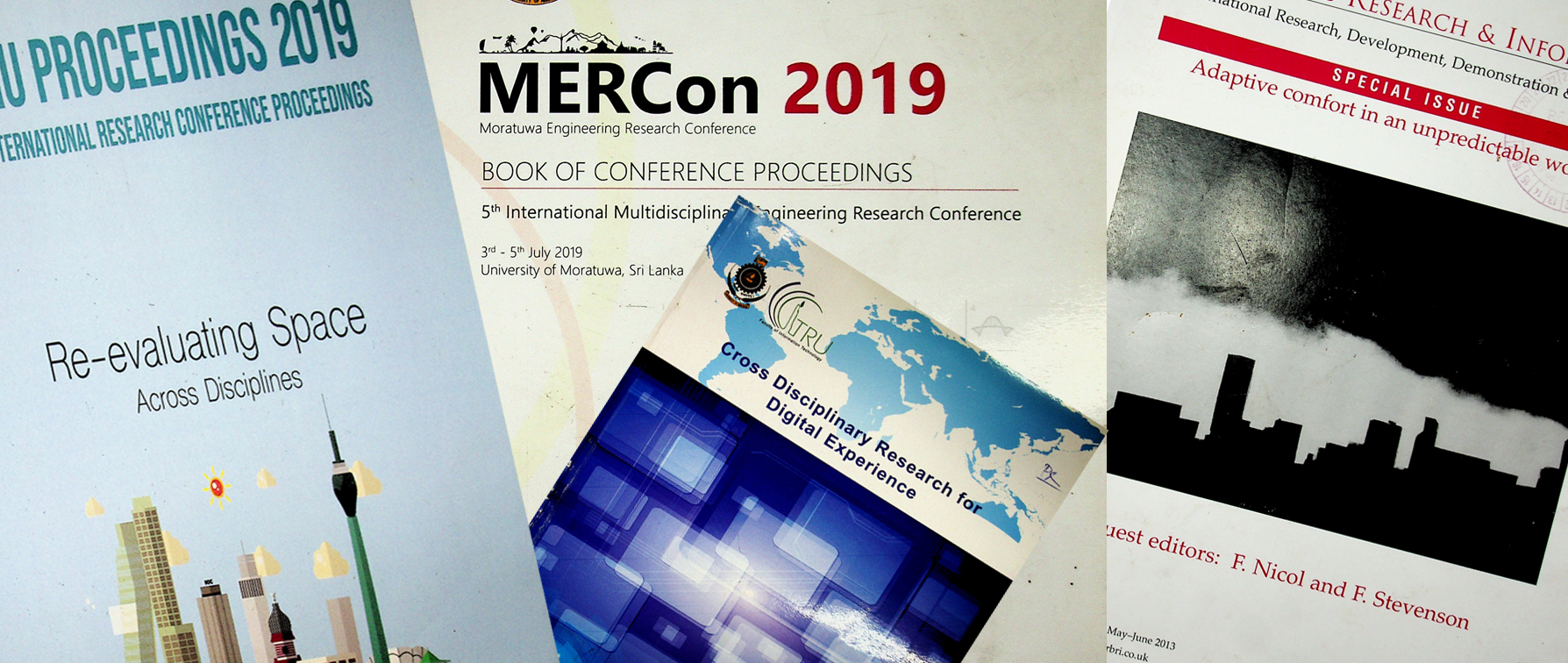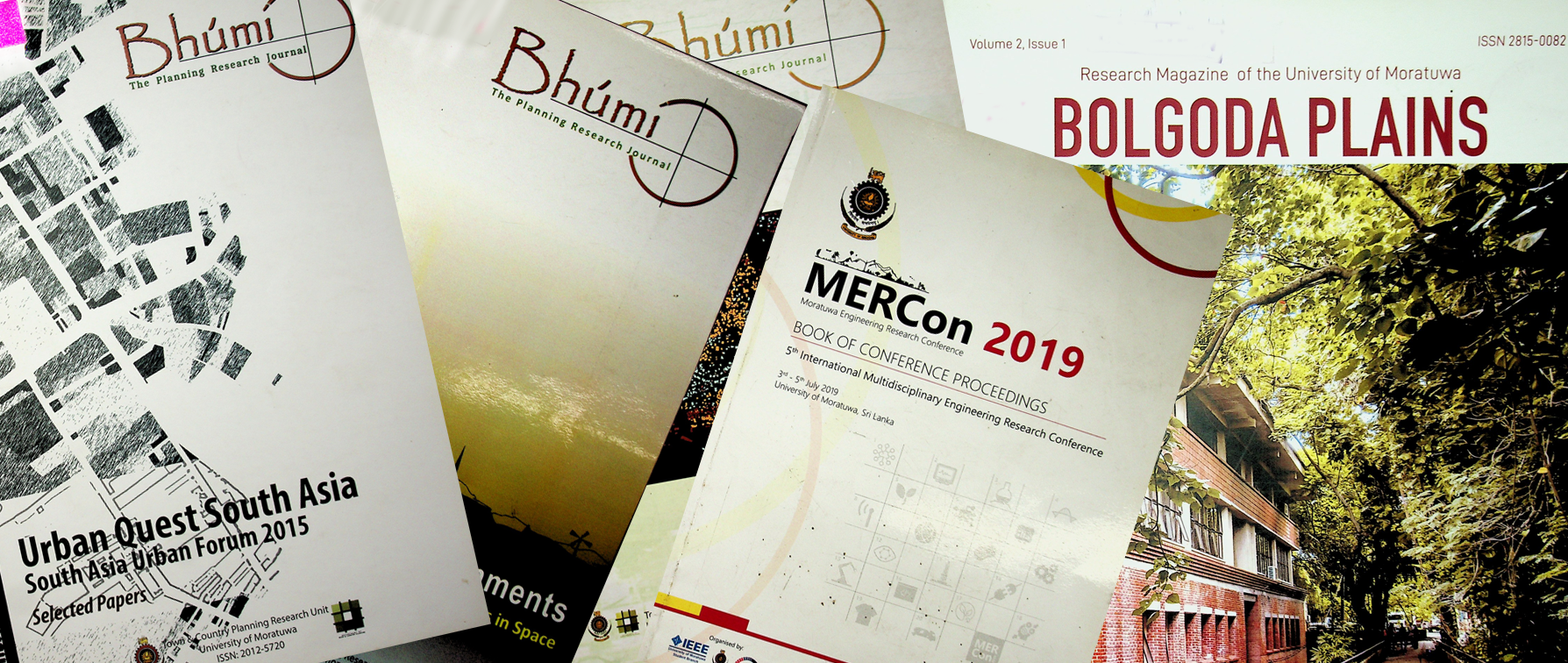Institutional-Repository, University of Moratuwa
Welcome to the University of Moratuwa Digital Repository, which houses postgraduate theses and dissertations, research articles presented at conferences by faculties and departments, university-published journal articles and research publications authored by academic staff. This online repository stores, preserves and distributes the University's scholarly work. This service allows University members to share their research with a larger audience.
 Research Publications |  Thesis & Dissertation |  E- Books |



 UoM Journal Publications |  UoM Conference Proceedings |  Articles published in Scimago's Q1 journals |  UoM Research Reports |  Other Articles authored by UoM staff |
Recent Submissions
item: Thesis-Abstract
Determination of field dry density of sandy soils using a dynamic cone penetration test
(2024) Wijesundara, AMIM; Nawagamuwa, UP
The degree of compaction plays a critical part in assessing the quality of soil layers during road and highway construction. However, conventional field density testing methods are time- consuming and may not fully ensure compaction compliance throughout construction. Thus, there is a need for efficient quality control and assurance procedures to maintain project progress while upholding construction quality.
This study aims to establish relationships between the Dynamic Cone Penetration (DCP) Rate and field dry density, facilitating efficient field density assessment without solely relying on traditional methods like the sand cone test. Although previous researchers have developed correlations to determine field dry density with the DCP penetration index, regression analysis results indicate their incompatibility with local soil conditions due to variations in soil formations and environmental factors. Hence, reliability analysis and modification are necessary to tailor these correlations to local conditions. Therefore, this study develops numerical correlations between the DCP penetration index (PRI) and field dry density (FDD) of subgrade soil using data obtained from laboratory and field investigations related to road construction. Following this, the outcomes of tests including Atterberg limits, sieve analysis, DCP penetration, Proctor Compaction, and field density tests are subjected to further analysis. Soil classifications were conducted in accordance with the Unified Soil Classification System (USCS).
The regression analysis is performed using MATLAB software, employing a curve fitting tool with robust regression options, such as Least Average Residual (LAR) and Bisquare, to mitigate the impact of outliers during model fitting. This study proposes to modify the existing correlations and two new correlations using regression analysis in the form of first and second- order numerical equations, with multiple variables representing the DCP Penetration Index (PRI) and the Field Moisture Content (FMC).
item: Thesis-Abstract
Critical evaluation of factors affecting success and failures of Sri Lankan government service major information technology projects : a case-study on the integrated treasury management information system of the Ministry of Finance Sri Lanka
(2024) Weerasekara, DM; De Silva , CR
The implementation of information technology (IT) projects in government service organizations has become increasingly important in recent years. These projects have the project management, and technology adoption. This research study critically evaluates the factors influencing the success and failures of major information technology (IT) projects undertaken by the Sri Lankan government service, specifically focusing on the implementation of the Integrated Treasury Management Information System (ITMIS) by the Ministry of Finance. IT project implementation in the public sector is known to be complex and challenging, impacting government services significantly. To identify the key factors that contributed to the success of failure of the ITMIS project, qualitative research methods were employed. In- depth interviews were conducted with key stakeholders, including government officials, IT professionals, and end-users directly involved in the project. The study examines various dimensions relevant to project success, such as project management practices, stakeholder engagement, technical challenges, organizational culture, and change management. By conducting a comprehensive analysis of these factors, the research provides valuable insights and recommendations to enhance the success of future IT projects within the Sri Lankan government service. The outcomes of this research contribute to the existing body of knowledge on IT project management in the public sector. Policymakers, project managers, and IT professionals engaged in similar initiatives can benefit from the practical recommendations derived from the study. These findings facilitate the improvement of project management practices, resource allocation, and the successful implementation of future IT initiatives within the public sector of Sri Lanka. The findings of this research shed light on critical insights into the factors influencing the success and failure of IT projects within the Sri Lankan government service, specifically focusing on the implementation of the Integrated Treasury Management Information System (ITMIS) by the Ministry of Finance. Through an in-depth examination of project management practices, stakeholder engagement, technical challenges, organizational culture, and change management, this study provides actionable recommendations to enhance the success of future IT projects in the public sector.
item: Thesis-Abstract
Impact of social media on career opportunities and career development in Sri Lankan software development industry : study on LinkedIn users
(2024) Hewage, UA; Wijayasiri, MPAP
In recent years, the advent of social media has revolutionized the way individuals communicate, network, and engage in professional interactions across various industries on a global scale. This research focuses on the influence of social media (LinkedIn) platform on career opportunities and career development, specifically within the context of the Sri Lankan software development industry. The study employs a survey-based approach to gather data from IT professionals working in Sri Lanka's software sector, aiming to uncover how these professionals utilize social media, particularly LinkedIn, to advance their careers and professional development. The findings from this study reveal significant insights into the role of LinkedIn as a social media platform for individuals and organizations within Sri Lanka's software development industry. The research highlights that social media (LinkedIn) serves as a crucial tool for networking, allowing professionals to connect with peers, industry leaders, and potential employers. LinkedIn, in particular, is shown to be instrumental in facilitating job searches, with many professionals using the platform to discover job opportunities, apply for positions, and stay informed about industry trends and vacancies. In addition to job searching, the study underscores the importance of social media (LinkedIn) in skill enhancement and personal branding. IT professionals in Sri Lanka are leveraging LinkedIn to showcase their skills, share their achievements, and build a professional online presence that can attract recruiters and potential collaborators. This aspect of personal branding is essential for career advancement, as it helps individuals stand out in a competitive job market. Furthermore, the research elucidates the role of social media (LinkedIn) in fostering knowledge exchange, collaboration, and community building within the software development industry. Platforms like LinkedIn provide a space for professionals to share insights, discuss industry developments, and collaborate on projects. This collaborative environment not only enhances individual knowledge but also contributes to the overall growth and innovation within the industry. The study contributes to the existing body of literature by providing empirical evidence on the impact of social media (LinkedIn) on career trajectories and professional growth within a specific geographical and industrial context. By focusing on the Sri Lankan software development industry, this research offers valuable insights that can inform individuals, organizations, and policymakers on how to effectively leverage social media (LinkedIn) to enhance career opportunities and foster career development. Overall, this research underscores the transformative impact of social media (LinkedIn) on the professional landscape of the Sri Lankan software development industry, offering a comprehensive understanding of its benefits and providing practical recommendations for various stakeholders aiming to harness its potential for career advancement and industry development.
item: Thesis-Abstract
Evaluating the ethical conduct of using personal data for digital marketing : a user perspective study
(2024) Shanika, HAATN; Hettiarachchi, HAC
This study investigates the ethical implications of using personal data for digital marketing from a user perspective. With the rise of big data and sophisticated algorithms, digital marketers leverage vast amounts of user data to deliver high targeted advertising campaigns. While this data driven approach offers undeniable benefits in terms of personalization and campaign effectiveness, it also raises significant ethical concerns. This research aims to explore user awareness of data collection practices, their concerns about informed consent and their perception on data privacy security.
Through a structured questionnaire survey, data was collected from young adults in Sri Lanka to assess their perceptions of these issues. The findings indicate that users value informed consent, with a significant portion expressing the need for clear explanations of data collection practices and greater control over their personal data. Additionally, moderate levels of concern were noted regarding data privacy and security, highlighting the necessity for digital marketers to address these issues to maintain user trust.
Based on these insights, the study provides several recommendations for improving the ethical use of personal data in digital marketing. These include enhancing transparency and communication, strengthening informed consent mechanisms, prioritizing data privacy and security, and fostering user education and awareness. By implementing these measures, companies can develop more ethical and user-centric digital marketing practices that respect user privacy and build trust.
item: Thesis-Abstract
An Investigation of the factors that influence IT engineers’ job retention in global IT companies operating in Sri Lanka
(2024) Madushani, HDA; Jayasena, S
With the rapid growth of Sri Lanka's IT business, particularly in software development, digital marketing, IT consulting, and related industries, understanding the factors impacting employee retention has been crucial. While research on employee retention in the IT sector exists, there is a noticeable gap in the literature about the Sri Lankan IT sector, particularly the retention of global IT companies operating in Sri Lanka. The study aims to address the gap by investigating the factors that influence retention among IT engineers in global IT companies operating in Sri Lanka. The study defines retention as the dependent variable and financial benefits, career development opportunities, work environment, and work-life balance as independent variables. Data analysis includes descriptive analysis, correlation analysis, hypothesis testing, and regression analysis to determine the correlations between the factors and identify the degree of their impact on employee retention. The findings suggest, that there is a strong positive significant relationship between retention and financial advantages, career development opportunities, work-life balance, and work environment. Financial benefits was identified as the most influential factor in employee retention, followed by career advancement, work-life balance, and the workplace. Based on the findings, key retention strategies are recommended for organizations including (a) Competitive compensation packages, (b) Employee well-being programs, (c) Performance-based incentives, (d) Professional development investments, and (e) Recognition and rewards. The study highlights the potential for more research to examine other aspects of retention, including the influence of DEI (Diversity, Equity, and Inclusion) programs and organizational culture in the IT industry
